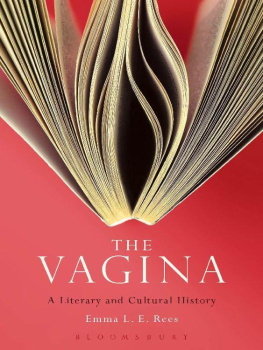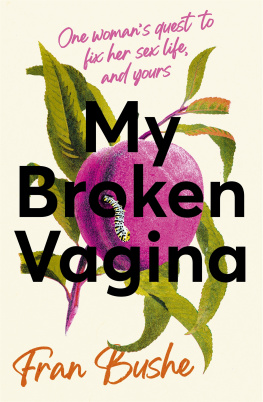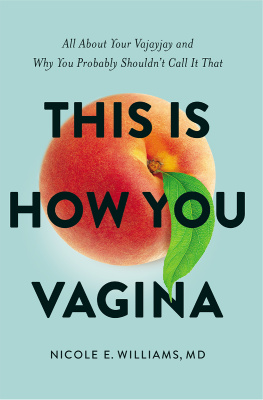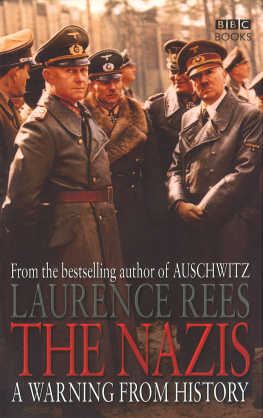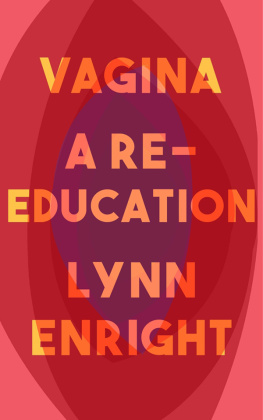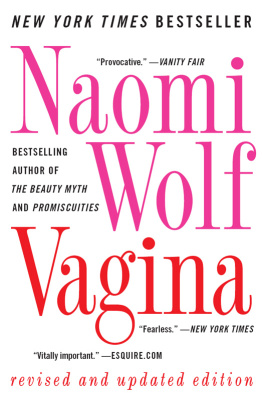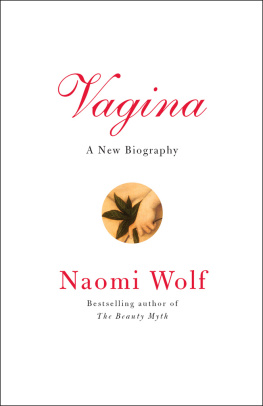Emma L. E. Rees - The Vagina: A Literary and Cultural History
Here you can read online Emma L. E. Rees - The Vagina: A Literary and Cultural History full text of the book (entire story) in english for free. Download pdf and epub, get meaning, cover and reviews about this ebook. year: 2013, publisher: Bloomsbury Academic, genre: Detective and thriller. Description of the work, (preface) as well as reviews are available. Best literature library LitArk.com created for fans of good reading and offers a wide selection of genres:
Romance novel
Science fiction
Adventure
Detective
Science
History
Home and family
Prose
Art
Politics
Computer
Non-fiction
Religion
Business
Children
Humor
Choose a favorite category and find really read worthwhile books. Enjoy immersion in the world of imagination, feel the emotions of the characters or learn something new for yourself, make an fascinating discovery.
- Book:The Vagina: A Literary and Cultural History
- Author:
- Publisher:Bloomsbury Academic
- Genre:
- Year:2013
- Rating:4 / 5
- Favourites:Add to favourites
- Your mark:
- 80
- 1
- 2
- 3
- 4
- 5
The Vagina: A Literary and Cultural History: summary, description and annotation
We offer to read an annotation, description, summary or preface (depends on what the author of the book "The Vagina: A Literary and Cultural History" wrote himself). If you haven't found the necessary information about the book — write in the comments, we will try to find it.
The Vagina: A Literary and Cultural History — read online for free the complete book (whole text) full work
Below is the text of the book, divided by pages. System saving the place of the last page read, allows you to conveniently read the book "The Vagina: A Literary and Cultural History" online for free, without having to search again every time where you left off. Put a bookmark, and you can go to the page where you finished reading at any time.
Font size:
Interval:
Bookmark:
The Vagina: A Literary and Cultural History
Emma L. E. Rees

Bloomsbury Academic
An imprint of Bloomsbury Publishing Plc
1385 Broadway New York NY 10010 USA
50 Bedford Square London WC1B 3DP UK
www.bloomsbury.com
First published 2013
Emma L. E. Rees, 2013
All rights reserved. No part of this publication may be reproduced or transmitted in any form or by any means, electronic or mechanical, including photocopying, recording, or any information storage or retrieval system, without prior permission in writing from the publishers.
No responsibility for loss caused to any individual or organization acting on or refraining from action as a result of the material in this publication can be accepted by Bloomsbury Academic or the author.
Library of Congress Cataloging-in-Publication Data
Rees, Emma L. E.
The vagina : a literary and cultural history / by Emma L.E. Rees.
pages cm
Includes bibliographical references and index.
ISBN 978-1-62356-871-9 (hardcover : alk. paper) 1. Vagina in literature. 2. Vagina in populare culture. I. Title.
PN56.V26R44 2013
700.4561dc23
2012050836
eISBN: 978-1-6235-6066-9
For my mother (Lizzie) and for Sue

Contents

Colour Figures

S pecial thanks go to Ally Jane Grossan at Bloomsbury for her professionalism, good humour and patience. The two readers for Bloomsbury made incredibly generous and enabling comments which generated many interesting thoughts and made this book better than it would have been without their input. Im also hugely grateful to my own three readers, who gave their time to comment on the manuscript: Lucinda Mitchell, Bryony Page and Nick Riddle. Artists and scholars who have given me invaluable help include: Virginia Braun, Keith Briggs, Judy Chicago, Robert Coover, Simon Croft, Tom DeSimone, Matthew Hunt, Mitchell Litchtenstein, Helen Knowles, Julia Kunin, Marcia Pointon, Annie Sprinkle, Jonathan Waller and Naomi Wolf. Those who have helped in other ways are too numerous to mention, but among them are: Jac Armstrong, Jon Cooke, Melissa Fegan, Judy Hayden, Clare Haynes, Barbara Holliday, Greg Hulsman, Ali Hutchinson, Bekky Jennings, Bianca Lisowski, Dawn Llewellyn, Anna Mackenzie, Chris Walsh, Chris Wood, Deborah Wynne and Louisa Yates. I also owe an immense debt of gratitude to all of the staff of the wonderful Gladstones Library in Hawarden, North Wales. Additionally, Id like to thank the many students through my years at the University of Chester who have always displayed just the right mixture of curiosity, disbelief and respect whenever I talked to them about this book.
This book is dedicated to two remarkable women: my mother Lizzie Rees and her partner, Sue Foster. Other family members have also shown me love and support when it has been most needed. Im thinking here of my mother-in-law, Alexis Waitman; my sister-in-law Charlie Weinberg; and my husbands father and stepmother, Tony and Gill Wilson. Finally, two people may have felt that they had no choice but to help with this book, because they were on the front line of the writing process: my patient, loving and supportive husband, Richard E. Wilson, and our beloved daughter and feminist force of the future, Sapphire Rees-Wilson. Thank you.
The mother of invention
Serendipity, not necessity, is the mother of invention. How else would a nice girl like me end up writing a book like this? In the summer of 1995, while driving through the borderlands of England and Wales in a Volvo so old that it imposed a leisurely pace on us, we saw an unremarkable sign pointing to Kilpeck Church. Turning off the road, we found an extraordinarily quirky Romanesque church in a fairly deserted spot. We parked, and wandered round on foot, our gaze drawn upwards to the ornate, Celtic-style stone carvings which dominated the grey faade. Dolphin-like swirls gave the weathered stone the appearance of effortless motion; a flow, as though waterborne. A line of gargoyles (which, I was later to learn, were actually corbels) was wrapped around the little church like a taut line of bizarre stone bunting (see ).
Very few of the 70 or so corbels which have survived the assaults of the weather, the Reformation, and, anecdotally, at least, the parasols of censorious Victorian women, depict recognizably conventional religious images. There are two very equine-looking representations of the Agnus Dei (Lamb of God), and human faces which, at a push, might be Adam and Eve, but most of what we saw that hot summers day in 1995 mystified us. Here, a weirdly cartoonish carved rabbit had, for over 800 years, been squashed next to a stone dog whose droopy ears projected an air of weary resignation; a bird-like monster was captured greedily eating a wide-eyed human being; and a knot of serpents bit down on their tails, their writhing at a standstill for the eternity the stonemason wanted them to represent. And then we saw her: a bald-headed, primitive figure crouched on the corbel table, her blank eyes somehow fixed on her observers, and her hands, inside her knees-akimbo, spreading her proportionately massive labia, exposing her vulva. What was she doing on this church? On any church? How could an image of such full-on femaleness possibly bear a sufficiently hallowed message? Did she justify her place on that sacred building through some sort of code which Hugh of Kilpecks stonemasons had understood in the twelfth century, but which was lost to us in the twentieth? ()

Figure 1.1Kilpeck Church showing the Corbel Table. Photo credit: Jon Cooke
We went into the cool, dark church to buy a guidebook, dutifully dropping our coins into the wooden honesty box where they made a hollow clang, briefly hushing the birdsong. Along with the guidebook came a reprint of an extract from a nineteenth-century guide written by G. R. Lewis. Blinking into the sunlight we used Lewiss meticulously illustrated guide to point out to one another the meanings of the different corbels we could see. All was going well until we reached that perplexing female figure. Here, Lewiss meticulousness roundly failed. His illustration of the corbel number 26, as he called it clearly showed the same bald-headed figure with the staring eyes. Lewiss figure, though, had its hands pointing outwards, to the sides, at complete odds with what we could see. Arms, tailing off into those deceitful little stone hands, seemed somehow to have replaced legs. What were evidently, albeit astonishingly, labia, had been transformed into an unobtrusive, shield-shaped mark. This nineteenth-century antiquarians illustration might be flawed, we reasoned, but what of his written description? 26 represents a fool, wrote Lewis, the cut in his chest, the way to his heart, denotes it is always open and to all alike. What did it mean, I wondered then, and still wonder now, for the female genitalia to be so very visible, and yet to be so blatantly and unapologetically eradicated?
Next pageFont size:
Interval:
Bookmark:
Similar books «The Vagina: A Literary and Cultural History»
Look at similar books to The Vagina: A Literary and Cultural History. We have selected literature similar in name and meaning in the hope of providing readers with more options to find new, interesting, not yet read works.
Discussion, reviews of the book The Vagina: A Literary and Cultural History and just readers' own opinions. Leave your comments, write what you think about the work, its meaning or the main characters. Specify what exactly you liked and what you didn't like, and why you think so.

